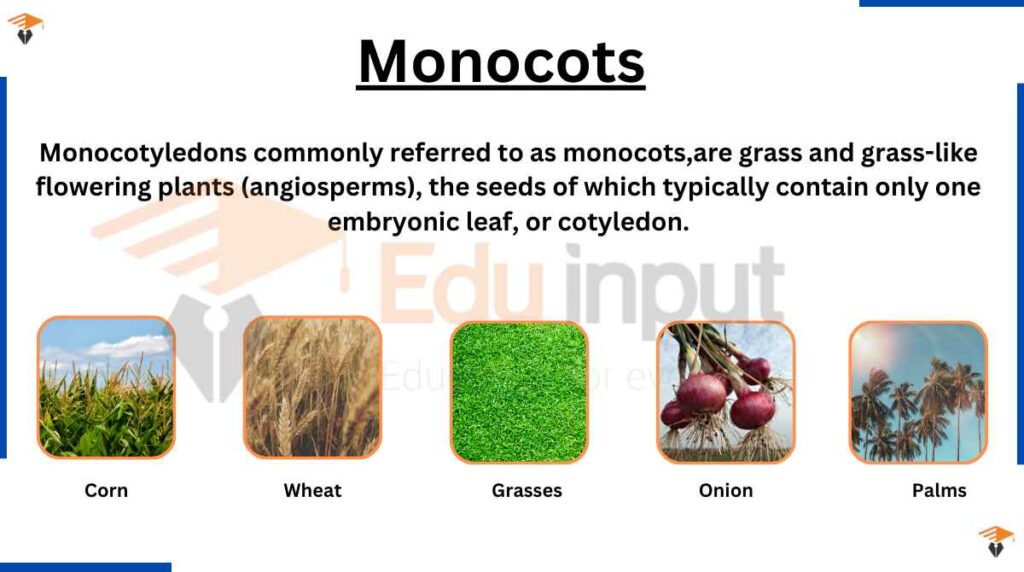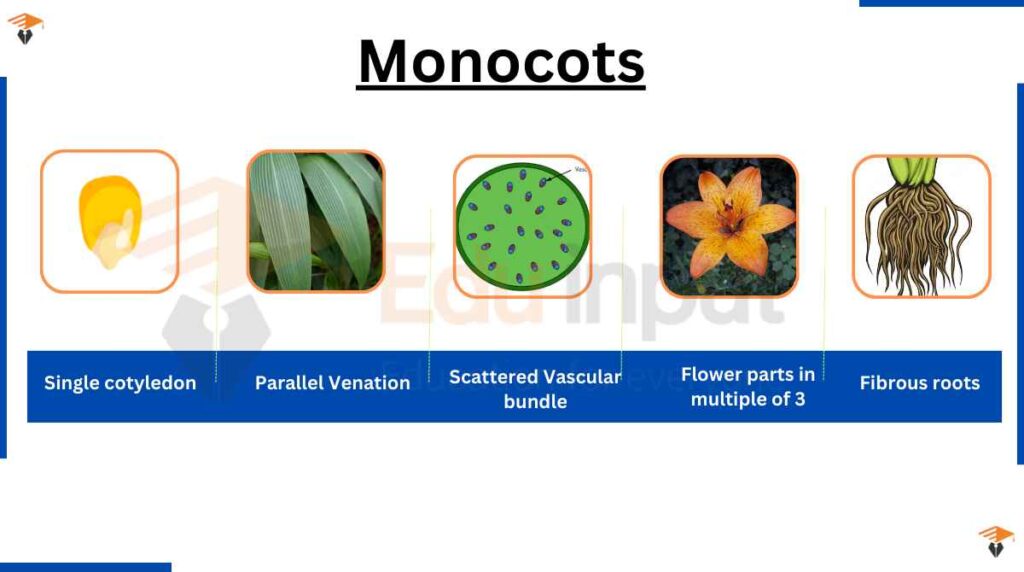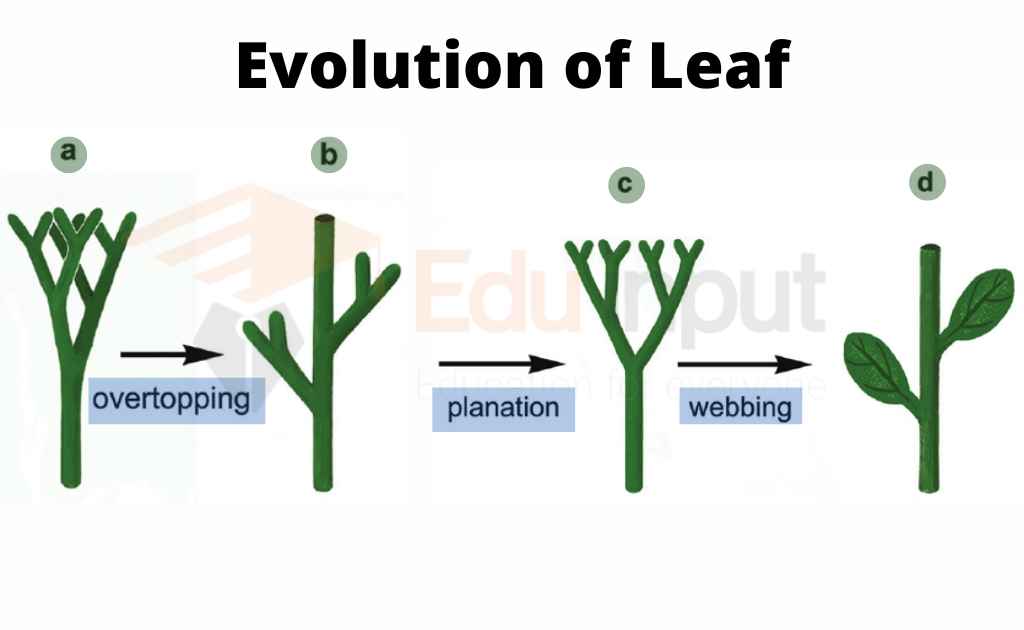Monocots-Organization, Forms, Morphology, and Root System
The term “monocotyledon” refers to the presence of a single cotyledon or embryonic leaf in their seeds. This is in contrast to dicots, which typically have two cotyledons.

Learn about Differences Between Monocots And Dicots
Taxonomy
Monocots are one of the five major lineages of mesangiosperms, which are a group of core angiosperms (flowering plants). Mesangiosperms make up 99.95% of all angiosperms. Among the mesangiosperms, monocots, and eudicots are the largest and most diverse radiations, that make 22.8% and 74.2% of all angiosperm species, respectively.
The grass family (Poaceae) and the orchid family (Orchidaceae) are economically significant families of monocots. The grass family represents 34% of all monocots, while the orchid family accounts for 17%. Both families are the largest families in the plant kingdom.
Organization, Growth, and Life Forms
Monocots have a different way of growing compared to other plants. They don’t have a special part that helps them grow wider as they get taller. This means their stems can’t become very thick. Most monocots are small plants like grasses, but some can grow tall and big, like agaves, palms, pandanus, and bamboo.
Water Transport Challenges
Because monocots can’t grow thick stems, they face challenges in transporting water efficiently. Some monocots, such as Yucca plants, have developed special ways to grow thicker over time.
Palm trees have a different type of growth called establishment growth, which helps them grow taller. However, because their stems can’t get very wide, monocots don’t have as many branches as other plants.
Adaptations and Unique Forms
Despite their limitations, monocots have found ways to adapt to different environments. Some, like orchids and bromeliads, grow on other plants and don’t need soil. There are even monocots that can live underwater.
Certain climbing vines and palms have abilities to grow toward dark areas and produce extremely long shoots. These adaptations help monocots survive and thrive in diverse conditions.
Leaf Morphology
The leaf of monocotyledons shows the following features:

Parallel Veins
Monocot leaves have a special feature with veins that run parallel to each other from the base to the tip of the leaf. This is different from other plants where veins form a net-like pattern.
Different Leaf Shapes
Monocots have a lot of variety in their leaf shapes. Some have long and narrow leaves like grasses, while others have broader and lance-shaped leaves like lilies.
Leaf Base and Cotyledon
The first leaf of a flowering plant called the cotyledon, has a different structure in monocots. The base of the leaf, called the hypophyll, is usually the most important part. This creates different shapes and sizes of leaves in monocots.
Sheathing and Linear Leaves
Mature monocot leaves are usually narrow and straight. They wrap around the stem at the bottom, which is called sheathing. This gives monocot plants a unique look.
Striate Venation
The veins in monocot leaves follow a pattern called striate venation. They can be curved or straight, but they run parallel to each other. This helps to transport water and nutrients in the leaf.
One Leaf per Node
Monocots usually have only one leaf growing from each spot on the stem. This is because the leaf base covers more than half of the stem’s circumference.
How Leaves Evolved
The special leaf shapes in monocots developed over a long time. It happened because of differences in how the leaves grow early on, rather than how the plant’s growing point works.
Root System in Monocots
Monocots typically possess a fibrous root system. This system consists of numerous thin roots that arise from the base of the stem. The fibrous roots provide stability to the plant and aid in the absorption of nutrients from the soil.
Unlike some other plants, monocots lack a special part called cambium, which limits the ability of their primary root to grow and thicken. To compensate for this, monocots develop adventitious roots, which originate from the stem. These additional roots contribute to the overall growth and nutrient uptake of the plant.
Underground Organs in Monocots
Monocots exhibit various underground organs that serve different functions. Some monocots develop runners and rhizomes, which are creeping shoots that grow along or just below the soil surface. Runners aid in vegetative propagation, have elongated internodes, and often bear scale leaves.
Rhizomes, on the other hand, may serve as storage organs in addition to their creeping function. Plants with rhizomes are known as geophytes. Monocots can also form bulbs, which are short stems with leaves at the base.
These bulbs store food and provide protection. Tubers and corms are other types of storage organs found in monocots. Tubers are swollen structures that form at the ends of underground runners and persist over time.
Corms are short-lived vertical shoots with terminal inflorescences and tend to shrink after flowering. Some monocots, known as geophilous shoots, produce shoots that grow directly into the soil. These underground shoots help overcome the limited trunk stability often seen in large woody monocots.
Reproduction in Monocots
Monocots reproduce by producing flower, but their flower have some specialized features that makes them different from dicots.
Flower of Monocot
Monocot flowers usually have two sets of three parts each, called tepals. Unlike other plants, monocots don’t have separate petals and sepals. In species that rely on animals for pollination, both sets of tepals can look like petals.
The flowers of monocots usually don’t stay open for very long. Some flowers can even open and close in response to temperature changes. About two-thirds of monocots are pollinated by insects. These plants use showy flowers to attract pollinators.
The flowers can be bright and noticeable to catch the attention of insects. Some flowers have other modified structures, like filaments or stylodia that help attract pollinators. However, some monocots have flowers that are not very noticeable but still get pollinated by animals.
These plants use things like scents or colored bracts (modified leaves) to attract pollinators. The perigone, which is the name for the tepals, also provides a landing spot for insects.
Fruit and Seed
The embryo inside a monocot seed has one cotyledon, which is like the first leaf of the plant. It usually has two vascular bundles, which are special tissues that help transport nutrients and water within the plant.
Apomorphies in Monocots
Apomorphies are specific characteristics that have evolved within the group of monocots and are not inherited from a common ancestor. Monocots have certain characteristics that evolved during their radiation and are not inherited from a common ancestor.
These apomorphies include:
- Herbaceous plants without woody stems.
- Leaves with parallel veins and sheathed base.
- Single-cotyledon embryos in seeds.
- Specific stem vascular arrangement (atactostele).
- Adventitious roots for stability and absorption.
- Sympodial growth with lateral branches.
- Flowers with three sepals, petals, stamens, and carpels.
Synapomorphies in Monocots
synapomorphies are shared characteristics that are derived from a common ancestor and define the monophyletic group of monocots. These synapomorphies contribute to the taxonomic stability of the group. It includes:
- Presence of calcium oxalate raphides.
- Absence of vessels in leaves.
- Monocotyledonous anther wall formation.
- Successive microsporogenesis for male spore production.
- Syncarpous gynoecium with fused carpels.
- Parietal placentation of ovules.
- Monocotyledonous traits in seedlings.

 written by
written by 


Leave a Reply